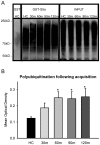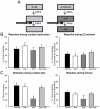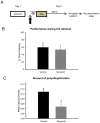Activity dependent protein degradation is critical for the formation and stability of fear memory in the amygdala
- PMID: 21961035
- PMCID: PMC3178530
- DOI: 10.1371/journal.pone.0024349
Activity dependent protein degradation is critical for the formation and stability of fear memory in the amygdala
Abstract
Protein degradation through the ubiquitin-proteasome system [UPS] plays a critical role in some forms of synaptic plasticity. However, its role in memory formation in the amygdala, a site critical for the formation of fear memories, currently remains unknown. Here we provide the first evidence that protein degradation through the UPS is critically engaged at amygdala synapses during memory formation and retrieval. Fear conditioning results in NMDA-dependent increases in degradation-specific polyubiquitination in the amygdala, targeting proteins involved in translational control and synaptic structure and blocking the degradation of these proteins significantly impairs long-term memory. Furthermore, retrieval of fear memory results in a second wave of NMDA-dependent polyubiquitination that targets proteins involved in translational silencing and synaptic structure and is critical for memory updating following recall. These results indicate that UPS-mediated protein degradation is a major regulator of synaptic plasticity necessary for the formation and stability of long-term memories at amygdala synapses.
Conflict of interest statement
Figures









Similar articles
-
NMDA currents and receptor protein are downregulated in the amygdala during maintenance of fear memory.J Neurosci. 2003 Nov 12;23(32):10283-91. doi: 10.1523/JNEUROSCI.23-32-10283.2003. J Neurosci. 2003. PMID: 14614087 Free PMC article.
-
Distinct subcellular changes in proteasome activity and linkage-specific protein polyubiquitination in the amygdala during the consolidation and reconsolidation of a fear memory.Neurobiol Learn Mem. 2019 Jan;157:1-11. doi: 10.1016/j.nlm.2018.11.012. Epub 2018 Nov 17. Neurobiol Learn Mem. 2019. PMID: 30458285
-
The ubiquitin-proteasome system as a critical regulator of synaptic plasticity and long-term memory formation.Neurobiol Learn Mem. 2013 Oct;105:107-16. doi: 10.1016/j.nlm.2013.03.009. Epub 2013 Apr 25. Neurobiol Learn Mem. 2013. PMID: 23623827 Free PMC article. Review.
-
Thalamic nucleus reuniens regulates fear memory destabilization upon retrieval.Neurobiol Learn Mem. 2020 Nov;175:107313. doi: 10.1016/j.nlm.2020.107313. Epub 2020 Sep 19. Neurobiol Learn Mem. 2020. PMID: 32956808
-
Synaptic transmission and plasticity in the amygdala. An emerging physiology of fear conditioning circuits.Mol Neurobiol. 1996 Aug;13(1):1-22. doi: 10.1007/BF02740749. Mol Neurobiol. 1996. PMID: 8892333 Review.
Cited by
-
The dorsal hippocampus mediates synaptic destabilization and memory lability in the amygdala in the absence of contextual novelty.Neurobiol Learn Mem. 2019 Dec;166:107089. doi: 10.1016/j.nlm.2019.107089. Epub 2019 Sep 26. Neurobiol Learn Mem. 2019. PMID: 31563610 Free PMC article.
-
Does PKM(zeta) maintain memory?Brain Res Bull. 2014 Jun;105:36-45. doi: 10.1016/j.brainresbull.2013.09.005. Epub 2013 Sep 26. Brain Res Bull. 2014. PMID: 24076105 Free PMC article. Review.
-
Females, but not males, require protein degradation in the hippocampus for contextual fear memory formation.Learn Mem. 2021 Jul 15;28(8):248-253. doi: 10.1101/lm.053429.121. Print 2021 Aug. Learn Mem. 2021. PMID: 34266989 Free PMC article.
-
Neuronal activity regulates the nuclear proteome to promote activity-dependent transcription.J Cell Biol. 2021 Dec 6;220(12):e202103087. doi: 10.1083/jcb.202103087. Epub 2021 Oct 7. J Cell Biol. 2021. PMID: 34617965 Free PMC article.
-
Context memory formation requires activity-dependent protein degradation in the hippocampus.Learn Mem. 2017 Oct 16;24(11):589-596. doi: 10.1101/lm.045443.117. Print 2017 Nov. Learn Mem. 2017. PMID: 29038220 Free PMC article.
References
Publication types
MeSH terms
Substances
Grants and funding
LinkOut - more resources
Full Text Sources
Medical

